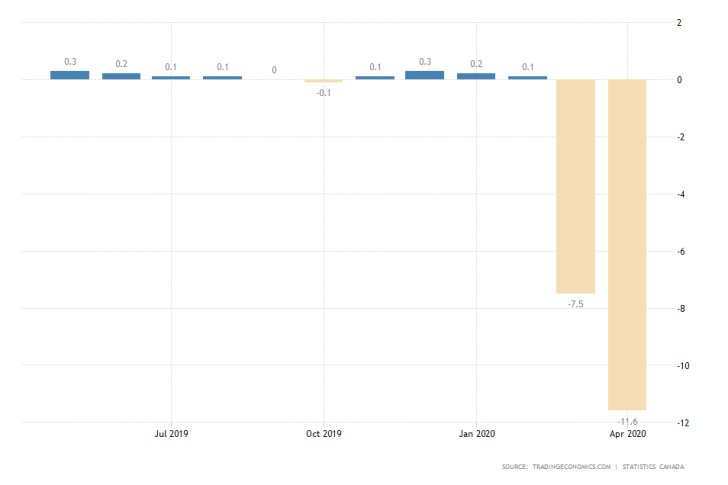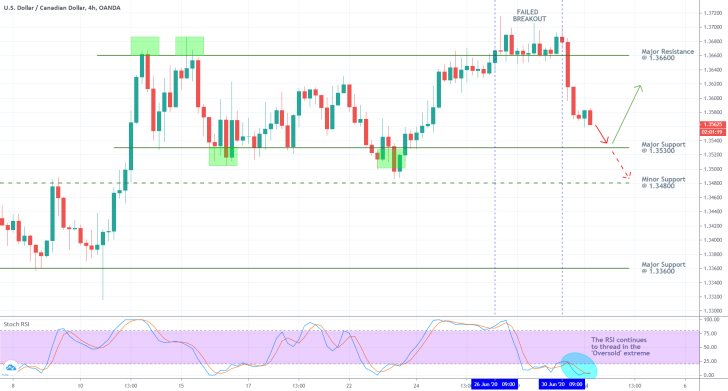
The Canadian economy expectedly contracted in April, which was during the height of the coronavirus crisis when most of the economy was closed down. The positive news is that the scope of the contraction was not as massive as initially feared.
According to Statistics Canada, the country's Gross Domestic Product shrank by 11.6 per cent, which fell short of the initial market forecasts for a dip measuring 12.5 per cent.

Canada was the only country from G7 to scale down its asset purchase program in early June. This was a surprising decision going against the general course of easing that other central banks were implementing at that time.
The outcomes from this controversial judgement to go against the tide are now starting to surface. While other countries are seeing a noticeable rebound in their economic activities, the adverse impact of the economic fallout that continues to weigh down on Canada's output does not seem to be waning.
The observed GDP decrease from yesterday can now be added to the poor retail numbers and the deflationary pressures that are continuously impeding Canada's price stability.
While medical experts are frequently slamming Sweden for its controversial response to the healthcare crisis, Canada is the OECD exception with equally dubious reaction to the financial crisis.
Nevertheless, the Bank of Canada's monetary policy could have its own merits. For one, its comparatively tighter stance would not generate as much debt during the worst of the economic slump.
In other words, the Canadian economy is struggling more now but should have a more relaxed time paying back its debt-financing operations when the recovery process starts picking up steam.
That is the reason as to why investors' sentiment remains relatively high despite the muted economic performance. It is also why the Loonie is not tanking right now.
As can be seen on the 4H chart below, the USDCAD attempted to break out above the major resistance level at 1.36600, and thereby establish a new bullish uptrend. However, the greenback started depreciating against the Loonie following the release of the GDP data yesterday.
Even though the market is clearly oversold, as can be determined from the Stochastic RSI indicator, the underlying price action is likely to continue falling in the immediate future.
The pair is most likely going to reach the consolidation range's lower boundary, which is represented by the major support level at 1.35300 before the prevailing market sentiment is challenged.

Trendsharks Premium
Gold is undergoing a correction, as investors take profits to offset losses from falling stock prices, impacting their margins. However, we anticipate a renewed wave of [...]
The Swiss stock market index is mirroring its global counterparts, such as Germany 40 and US100, experiencing a sharp decline following the announcement of new [...]
We’re analyzing the weekly chart to grasp the broader market trend. Over the past three years, the US30 index has surged by 17,000 points, often resembling a nearly straight [...]
Over the past week, the DAX has experienced a sharp decline, plunging by an astonishing 3,400 points. This downward movement is not isolated, as its international counterparts, such as the UK100 and US100, are also facing significant [...]
EURUSD recently formed a double top at 1.0930, signaling a potential trend reversal, and has since begun a correction. After a 600-pip rally since early March, a pullback at this stage is both expected and healthy. Given these conditions, we are placing a [...]
Since early March, EURJPY has surged nearly 1,000 pips, providing us with several excellent trading opportunities. However, as the rally matures, many early buyers are beginning to take profits, leading to a noticeable slowdown in the uptrend. On Friday, the pair formed a [...]
The AUDJPY currency pair continues to be dominated by bullish momentum, as multiple golden cross patterns reaffirm the strength of the ongoing uptrend. Despite this, we are witnessing a much-needed [...]
The EURAUD currency pair appears to be undergoing a trend reversal, signaling a potential shift in market direction. A notable technical development is the formation of a Death Cross on the chart, a widely recognized bearish indicator that typically suggests a [...]
After securing an impressive 200-pip profit last week, the EURJPY currency pair is now undergoing a southward correction, retracing some of its recent gains. Despite this temporary pullback, the Golden Cross remains intact, reinforcing our view that the overall trend continues to be [...]
The appearance of a Golden Cross in Silver strengthens our analysis that the metal is currently in a strong uptrend, indicating further bullish momentum in the market. This technical pattern, where the short-term moving average crosses above the [...]
This trade presents a considerable level of risk and can be classified as an opportunistic move based on recent price action. The GBPUSD currency pair has experienced a substantial bullish rally, surging by nearly 500 pips in a strong upward movement. However, after this extended period of appreciation, the pair is showing signs of a potential [...]
The anticipated Death Cross on the SMI20 appears to be failing as price finds strong support at the 23% Fibonacci retracement level. After testing this area, the index has shown bullish strength, printing several large green candles, signaling an increase in [...]
A Golden Cross has just appeared on the USDJPY chart, signaling a potential bullish move. This technical pattern occurs when the 20 period moving average crosses above the 60 period moving average, a widely recognized indication of increasing [...]
After 2 months of a down trend, we finally see some indications of price recovery for Oil. The golden cross, a historic buy signal, supports this [...]
For the past month, the German DAX40 has experienced a remarkable 10% surge, reflecting strong bullish momentum. Despite ongoing market volatility and frequent pullbacks, every dip continues to attract fresh buyers, reinforcing the [...]
Oil continues its downward trajectory, despite occasional pullbacks. The overall trend remains bearish, reinforced by multiple Death Cross patterns, a classic sell signal indicating further weakness. Adding to this bearish outlook, the critical [...]
Over the past few days, gold has experienced a sharp decline of more than $100. This downturn can be attributed in part to traders securing profits to manage their margins, which are under strain due to the significant drop in major indices. Currently, gold has fallen below the [...]
The NASDAQ 100 index is showing strong bullish momentum, as evidenced by the formation of a Golden Cross on the chart. This classic buy signal occurs when the short moving average crosses above the long term moving average, suggesting that upward momentum is [...]
The EURAUD currency pair has encountered a significant resistance level, failing to break above the critical 61% Fibonacci retracement level. This suggests that bullish momentum is weakening, reinforcing the case for a potential downward move. Given this technical setup, we favor entering a [...]
The UK100 is experiencing a remarkable rally! Over the past few weeks, the British stock market index has surged nearly 800 points. Each minor dip has attracted more buyers, fueling the bullish momentum. However, since last week, we’ve observed a slight [...]




















